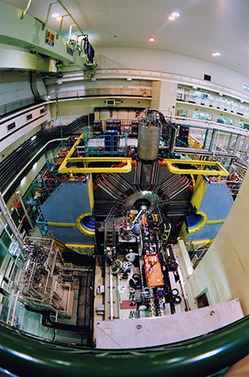Scientists at the KEKB accelerator have examined more than 700 million particles for a rare decay process that violates the Standard Model of particle physics

Fig. 1: The Belle detector at the KEKB accelerator in Tsukuba, Japan. The detector identifies particles produced by collisions between high-energy electrons and positrons by following the particle tracks in a 1.5 tesla magnetic field.
c 2010 KEK Image Archive
Scientists at Nagoya University are part of the large, international Belle Collaboration working to understand the phenomena in which our current theory of particles and their interactions -- known as the 'Standard Model' -- breaks down. The researchers have spent eight years searching for a rare particle decay that violates the Standard Model, and this has involved analyzing the decay of no less than 719 million tau particles produced at the KEKB electron-positron collider in Tsukuba, Japan1.
The Belle researchers have collected 50 times more data than earlier experiments, and made painstaking efforts to reduce false signals. Even so, they report no observation of the rare decay. This null result does not rule out the possibility that other theories beyond the Standard Model exist, but it strictly limits the uncertainties on certain model parameters -- particularly because the KEKB is arguably the best facility in the world for this type of investigation.
"Other colliders cannot produce such a large number of tau particles with so small a background environment," explains Kenji Inami, an associate professor at Nagoya University.
Physicists know that the Standard Model has some serious flaws. The model is unable, for example, to explain the masses of certain particles, or why there is more matter than antimatter in the universe -- an imbalance known as charge-parity violation.
Over time, theorists have patched up the Standard Model to explain these mysteries, but because these 'extensions' only have effects in extreme situations -- the conditions at the Big Bang, for instance -- the probability of observing them is exceptionally small. Particle physicists therefore examine millions of particle collisions to find the one or two events that signal a deviation from the physics of the Standard Model.
The Belle collaboration, which is dedicated to searching for evidence of charge-parity violation, has an impressive detector (Fig. 1) mounted at the KEKB accelerator, in which electrons and positrons collide to produce a large family of high-energy, short-lived particles, including the tau. Like the electron, the tau is classified as a lepton in the particle physics family, but only survives for a trillionth of a second and is 3,000 times as massive.
Since the 1980s, experimentalists have searched for evidence that the decay of the tau into secondary particles violates the rules of the Standard Model, in a process called 'lepton flavor violation'. The Belle experiment has now made this possibility even more remote.
Despite these dwindling odds, Inami explains that the search is still limited by the number of tau decays. He looks forward to the Belle-II experiment, which is expected to produce 50 times more events.
Affiliated Researchers
The Nagoya University affiliated authors mentioned in this highlight are from the Quest for Fundamental Principles in the Universe GCOE program of the Division of Particle and Astrophysical Science (Physics)
Reference
- Belle Collaboration: Hayasaka, K. et al. Search for lepton-flavor-violating τ decays into three leptons with 719 million produced τ+τ- pairs. Phys. Lett. B 687, 139 (2010). | article